
Map of the Chesapeake region showing the location of the principal archaeological sites discussed in the text. (Artwork, Nichole Drgan.)
1. Swan Cove
2. Homewood’s Lot
3. Burle’s Town Land
4. Broadneck
5. Old Chapel Field
6. St. Mary’s City (Pope’s Fort, St. Johns)
7. Nomini Plantation
8. Shirley Plantation
9. Walter Aston
10. Jordan’s Point
11. Flowerdew Hundred
12. Jamestown
13. College Landing
14. Kingsmill Tenement – Pettus
15. Bennett Farm
16. Harborview (Nansemond Fort)
17. Chesopean

Drawing of pipe mold, 1688. From Randle Holme’s Academy of Armory, shelfmark HARLEY.5955; FJ/245. (© British Library Board)
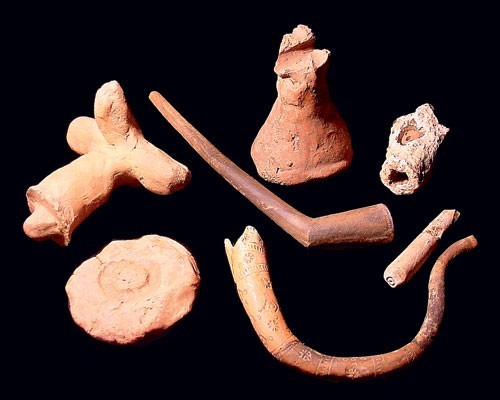
Kiln furniture and pipes, Emanuel Drue, Maryland, ca. 1660. Earthenware. (Courtesy, Anne Arundel County, Maryland; photo, Al Luckenbach.) Recovered from the Swan Cove site, these artifacts include cross-pipe props, decorating tool, bun, and pipes.

Tobacco pipes, Emanuel Drue, Maryland, ca. 1660. Earthenware. Top: Drue Type B, belly bowl. Center: Drue Type A, angular elbow. Bottom: presentation “Crumm Horn” pipe. (Courtesy, Anne Arundel County, Maryland; photo, Al Luckenbach.)

Tobacco pipe, Robert Cotton, Virginia, ca. 1608. Earthenware. (Preservation Virginia; photo, Beverly A. Straube.) This decorated elbow pipe is from the Jamestown excavations.
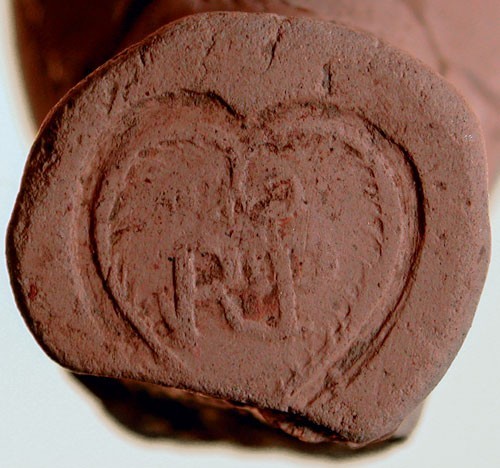
Tobacco pipe, Richard Pimmer, Virginia, ca. 1659. Earthenware. D. of spur .67"; H. of bowl 1.69". Mark: “RP” on pipe spur. (Courtesy, Virginia Department of Historic Resources; photo, Taft Kiser.) This pipe was found at the Nansemond Fort site (44SK192).

Tobacco pipe, Bookbinder, Virginia, ca. 1640. Earthenware. D. of stem .47"; D. of bore .15". (Courtesy, Virginia Department of Historic Resources; photo, Taft Kiser.) This angular elbow pipe is from the Chesopean site (44VB48).
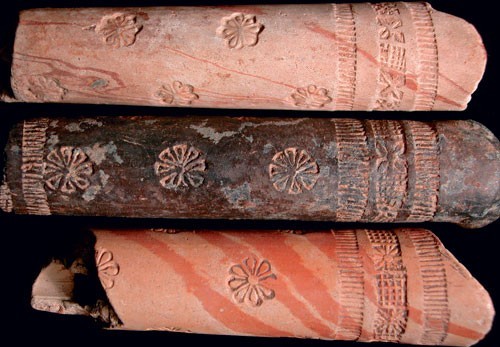
Tobacco pipe stems, Bookbinder, Virginia, ca. 1640. Earthenware. D. of pipe stem (average) .47"; D. of bore .14". (Courtesy, Virginia Department of Historic Resources; photo, Taft Kiser.) These three stems, found at the Chesopean site (44VB48), show the strict decorative grammar used by Bookbinder.

Tobacco pipe, Bookbinder, Virginia, ca. 1640. Earthenware. D. of stem .47"; D. of bore .14". (Courtesy, Virginia Department of Historic Resources; photo, Taft Kiser.) This close-up of a pipe from the Chesopean site (44VB48) shows Bookbinder’s detailed “grill work” decoration.
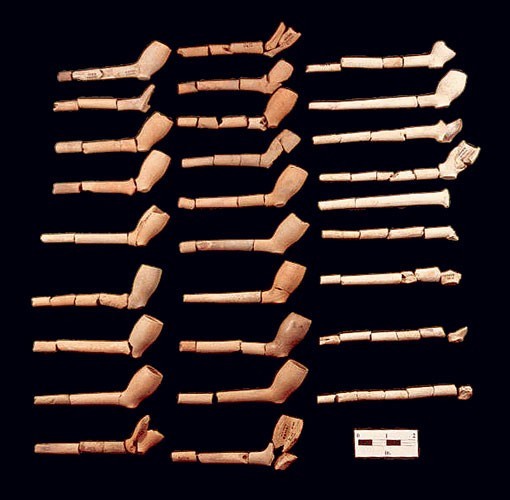
Tobacco pipes, Broadneck maker, Maryland, ca. 1650. Earthenware. (Courtesy, Anne Arundel County; photo, Al Luckenbach.) This complete assemblage of pipes from the Broadneck site (18AN818) shows the predominance of the Broadneck style.

Tobacco pipe, Broadneck maker, Virginia, ca. 1650. Earthenware. H. of bowl 1.61"; D. of bore .12". (Courtesy, Virginia Department of Historic Resources; photo, Taft Kiser.) This Broadneck bowl was found at the Wills Cove site (44SK56).

Tobacco pipe, Broadneck maker, Virginia, ca. 1650. Earthenware. D. of rim .75". (Courtesy, Virginia Department of Historic Resources; photo, Taft Kiser.) Broadneck rim decoration adorns this pipe from the Wills Cove site (44SK56).

Tobacco pipe, possibly J. Drue, ca. 1645. Earthenware. Mark: “JD.” (Courtesy, Preservation Virginia; photo, Beverly A. Straube.) This Broadneck-style pipe was recovered at the Jamestown excavations.
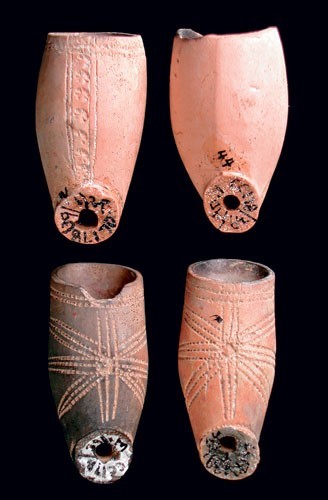
Tobacco pipes, Star Maker, Virginia, ca. 1640. Earthenware. H. of bowls (average) 1.65"; D. of bores .11–.12". (Courtesy, Virginia Department of Historic Resources; photo, Taft Kiser.) The Star Maker’s decorative grammar is represented on these four pipes from the Walter Aston site (44CC178).

Tobacco pipe, Star Maker school, Virginia, ca. 1640. Earthenware. H. of bowl 1.5"; D. of bore .12". Mark: “WA” (Walter Aston?). (Courtesy, Virginia Department of Historic Resources; photo, Taft Kiser.) This Star Maker pipe was found at the Walter Aston site (44CC178).

Tobacco pipe, Star Maker school, Virginia, ca. 1640. Earthenware. H. of bowl 1.26". Mark: “DK” (David Kirke?). (Courtesy, Virginia Department of Historic Resources; photo, Taft Kiser.) This example is from the Walter Aston site (44CC178).

Tobacco pipe, Star Maker school, Virginia, ca. 1640. Earthenware. Mark: “DK” (David Kirke?). (Courtesy, Colony of Avalon Foundation; photo, Jim Tuck and Barry Gaulton.) This Star Maker pipe was found in Newfoundland. At left is the decorated mark that appears on one side of the bowl; at right is the bowl’s reverse side, showing a star decoration.
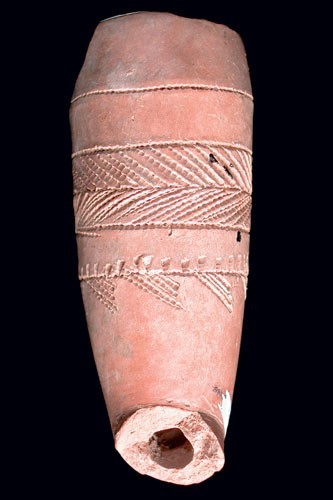
Tobacco pipe, Nomini Maker, Virginia, ca. 1660. Earthenware. H. of bowl 2.17"; D. of bore .17". (Courtesy, Virginia Department of Historic Resources; photo, Taft Kiser.) This version of a Nomini pipe was found at the Nomini Plantation (44WM12).

Tobacco pipe, Nomini Maker, Virginia, ca. 1660. Earthenware. H. of bowl 1.93"; D. of bore .15". (Courtesy, Virginia Department of Historic Resources; photo, Taft Kiser.)

Tobacco pipe, Nomini Maker, Virginia, ca. 1660. Earthenware. H. of bowl 1.85". (Courtesy, Virginia Department of Historic Resources; photo, Taft Kiser.)

Tobacco pipe, Nomini Maker, Virginia, ca. 1660. Earthenware. H. of bowl 2.17". (Courtesy, Virginia Department of Historic Resources; photo, Taft Kiser.) Illustrated here is an example of a Running Deer pipe.
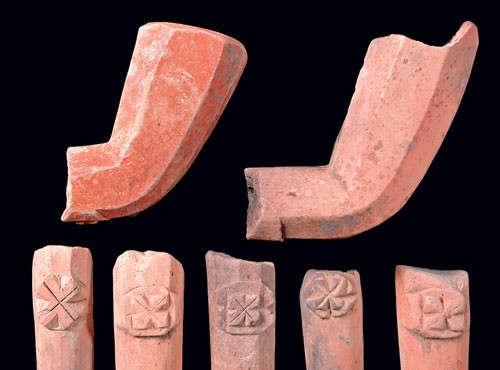
Tobacco pipes, The Carver, Virginia, ca. 1640. Earthenware. H. of bowl (average) 1.65"; D. of bore (average) .14". (Courtesy, Virginia Department of Historic Resources; photo, Taft Kiser.) This assemblage of bowls and stems is from the Kingsmill Tenement (44JC39).

Pipe-making waste, Pope’s Fort Maker, Maryland, ca. 1646. Earthenware. (Courtesy, Historic St. Mary’s City, Maryland; photo, Silas Hurry.) This waste is from the moat at Pope’s Fort.
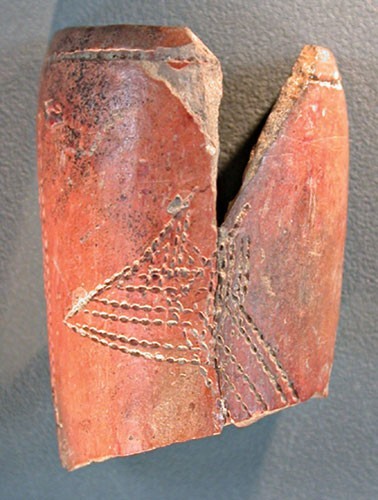
Tobacco pipe, Maryland, ca. 1660. Earthenware. (Courtesy, Anne Arundel County; photo, Shawn Sharpe.) Traditional Running Deer pipe from the Homewood’s Lot site, Anne Arundel County, Maryland.
